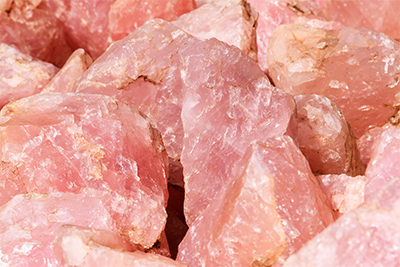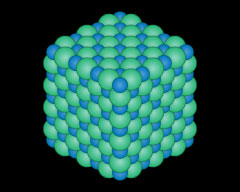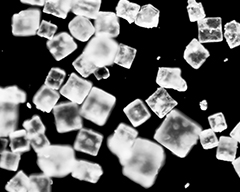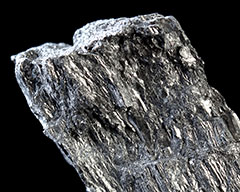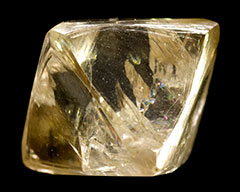Defining Minerals: Composition and crystal structure
Listen to this reading
Did you know that identifying minerals is what led scientists to conclude that there was water on Mars? Understanding of the specific conditions necessary for different minerals to form helps scientists understand the history of Earth and can even shed light on the search for extraterrestrial life.
Humans have always used materials from the earth selectively. Early human artists who painted on rock walls made their own paints from red and yellow pigments present in soils, pigments we now know as the minerals hematite and ochre. Countries have fought wars and trade companies battled over deposits of table salt, also called halite, in the East Indies. Today, we build our houses out of drywall, made of gypsum; we make cement out of lime, a calcium oxide mineral; and we extract aluminum from the mineral bauxite to make aluminum foil and soda cans.
Hematite, halite, gypsum, lime, and bauxite are all minerals, naturally formed materials that have a specific chemical composition and crystal structure. Minerals are the building blocks of rocks, which can be composed of one or more minerals in varying amounts. Granite, for example, contains quartz, mica, feldspar, and other minerals. Marble, on the other hand, consists entirely of the mineral calcite. Although minerals combine to form rocks, they retain their own characteristics, much like the ingredients in a salad. You can make a salad that contains a variety of vegetables, like lettuce, carrots, bell peppers, and sprouts, or you can make a salad that consists solely of lettuce. In either case, the individual components are still identifiable, the way minerals can be identified within a rock.
Fortunately, most minerals form only under certain conditions, so by identifying the minerals present in a rock, scientists can start to understand how, where, and maybe even when that rock formed. Understanding mineral formation also means that scientists can predict where to find economically important minerals like bauxite, and gemstones like diamonds.
Early study of minerals
Initially, most miners knew little about how minerals formed, but a lot about extracting the materials they found valuable. Georgius Agricola, a German physician who was much more enthusiastic about mining than medicine, documented mining practices and mineral descriptions in his book De Re Metallica, published in 1556. The title literally translates as "On the Nature of Metals," but at that time the word "metal" was widely used to describe any material from the earth. Agricola describes every aspect of mining, from how to identify minerals to 16th-century techniques for crushing ore to the uses of minerals and the diseases that they could cause (see the Classics link under the Resources tab to see original woodcuts from De Re Metallica).
Agricola's book remained a mining standard for nearly two hundred years and is considered the first major contribution to the science of mineralogy. Despite the comprehensive nature of the book, Agricola had little understanding of the fundamental composition of minerals – in other words, he had no way of knowing their chemical formulas. Though much thought had been devoted to the concept of atoms, the experiments that would allow scientists to define the nature of atoms, and thus the chemical composition of minerals, were more than 200 years away when Agricola began writing. Thus, early on, the science of mineralogy advanced on the basis of describing the shape of minerals and their defining properties, like hardness, instead of their atomic structure.
Comprehension Checkpoint
Defining a mineral
The word "mineral" means something very specific to Earth scientists. By definition, a mineral:
- Is naturally formed;
- Is solid;
- Is formed by inorganic processes;
- Has a specific chemical composition; and
- Has a characteristic crystal structure
Though each of these aspects of a mineral may seem simple, they have important implications when considered together.
1. Naturally formed: Minerals form through natural processes, including volcanic eruptions, precipitation of a solid out of a liquid, and weathering of pre-existing minerals. Today, scientists, engineers, and manufacturers synthesize many ceramics, plastics, and other substances with a specific chemical composition and structure, but none of these synthetic substances is considered a true mineral.
2. Solid: Liquids and gases are not considered minerals, in large part because their structure is constantly changing, which means they do not have a characteristic crystal structure. A true mineral must be solid.
3. Formed by inorganic processes: Any material produced through organic activity – such as leaves, bones, peat, shell, or soft animal tissue – is not considered a mineral. Most fossils, although they were once living, have generally had their living tissues completely replaced by inorganic processes after burial; thus, they are considered to be composed of minerals as well.
4. Specific chemical composition: Most minerals exist as chemical compounds whose compositions can be expressed using a chemical formula. The chemical formula of salt, or halite, is NaCl, meaning each molecule of salt consists of one sodium atom (Na) and one chlorine atom (Cl). Other common minerals have much more complicated formulas, such as muscovite (KAl2(AlSi3O10)(OH)2). A few minerals, such as graphite, consist of only one type of atom (carbon, in this case); therefore, the chemical formula for graphite is written simply as C. All minerals are defined by their chemical composition. If we tried to change the composition of muscovite by replacing the aluminum with iron and magnesium, for instance, we would end up with a totally new and different mineral called biotite.
On the other hand, many minerals do contain impurities, and these impurities can vary. Quartz, for example, has the chemical formula SiO2 and generally does not have any color in its pure form. The presence of a minute amount of titanium (Ti), however, causes the slight pinkish coloration present in rose quartz, as seen in Figure 1. The amount of titanium relative to the amount of silicon and oxygen is on the order of parts per million, however, so this is considered an impurity rather than a change in the chemical composition. In other words, rose quartz is still quartz. Similarly, the gemstone amethyst is a form of quartz that is colored pale to deep purple by the presence of the impurity iron (Fe).
It was not until the 1900s, 350 years after Agricola's book, that scientists were able to determine the specific chemical composition of minerals. The invention of the mass spectrometer, ever more powerful microscopes, and the use of diffraction techniques allowed the kind of highly detailed analysis that caused the science of mineralogy to flourish.
5. Characteristic crystal structure: Nicolaus Steno, a Dutch contemporary of Isaac Newton, made an important contribution to mineralogy in 1669 when he noted that the angles between faces (or sides) of quartz crystals were constant, no matter how big the crystals were or where they had formed. Today, we know that Steno's Law of Interfacial Angles concerning the external appearance of crystals reflects a regular, internal arrangement of atoms. The angles are constant between faces on quartz crystals because every single quartz crystal is made of the same atoms: one atom of silicon for every two atoms of oxygen, written with the molecular formula SiO2.
The chemical composition of a mineral is reflected internally in a regular, repeating arrangement of atoms, called the crystal structure of the mineral. The crystal structure of halite is shown in Figure 2. The internal structure (shown on the left) is reflected in a generally consistent external crystal form (shown on the right), as noted by Steno. The cubic shape of salt crystals very clearly reflects the right-angle bonds between the Na and Cl atoms in its atomic structure (see our Chemical Bonding module).
Most importantly, this structure repeats itself. As the halite crystal is broken into smaller and smaller pieces, it retains its cubic structure. Take a look at a dash of table salt under a microscope and you will confirm that this is the case.
Comprehension Checkpoint
The importance of crystal structure
The graphite-diamond mineral pair is an extreme example of the importance of crystal structure. These two very different minerals have exactly the same chemical formula (C), but the crystal structure of the two minerals is very different. In graphite, carbon atoms are bonded together along a flat plane, as shown in Figure 3. These sheets of carbon are loosely held together by weak attractive forces. However, the attractive forces between sheets can be easily broken, allowing them to slide past one another. Thus graphite is a soft, slippery mineral that is often used as a lubricant in machines (see Figure 4). When graphite is rubbed against another material, such as a piece of paper, it leaves a trail of small sheets that have broken free, thus it is also used in pencils.
In diamond, by comparison, every single carbon atom is bonded strongly to four surrounding carbon atoms in a 3-dimensional structure (see Figure 5). This structure results in one of the hardest natural substances on the planet (see Figure 6), a property that contributes to its value. The structure of each of these minerals is crucial to determining their physical properties.
Chemical composition and crystal structure are the most important factors in determining the properties of a mineral, including shape, density, hardness, and color. Geologists use these properties to identify which minerals are present in rocks. Hardness and fracture characteristics can be easily determined in the field with a small magnifying lens and a hammer, allowing for rapid identification of the mineral.
The internal atomic structure of graphite and diamond, shown in Figures 3 and 5, explains the properties of the two minerals.
Comprehension Checkpoint
Why do we care?
By identifying the minerals present in a given rock, geologists can begin to understand the history of that rock. Some minerals form only when magma erupts out of a volcano and cools, others form only deep within Earth's crust under tremendous heat and pressure, and still others form only at the surface through evaporation. The basalt that erupts out of the volcanoes in Hawaii, for example, contains olivine, a mineral that forms only within Earth's mantle at depths greater than 70 km. This tells us that the source of the magma in the Hawaiian Islands is very deep. Sediment cores from the bottom of the Mediterranean Sea contain layers of gypsum and halite, two minerals that form only when water evaporates; this discovery led geologists to the conclusion that the Mediterranean Sea had dried up repeatedly in the past.
Identifying minerals on other planets has also led to a greater understanding of our solar system. Hematite is a mineral that forms most commonly on Earth's surface in the presence of water. It is, essentially, rust, and it forms during weathering of iron-bearing minerals. The discovery of hematite "blueberries" on Mars was part of the evidence that led geologists to conclude that there once was liquid water on the planet.
The study of minerals began with mining, and we still use our knowledge of minerals to find important economic deposits. But our understanding of mineral composition and structure has become essential to many other areas of study as well. The environmental remediation of mines, the exploration of other planets and search for extraterrestrial life, and the study of the geologic history on our own planet are all areas that require knowledge of minerals and their sources.
